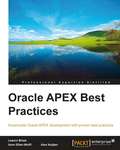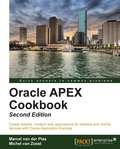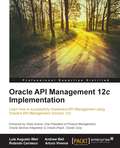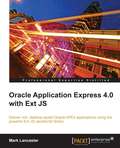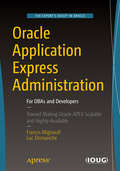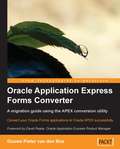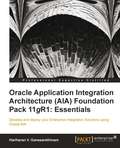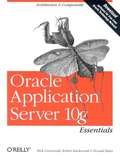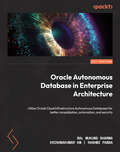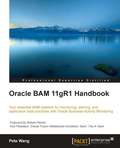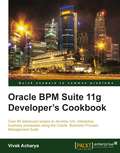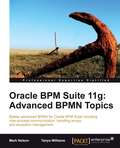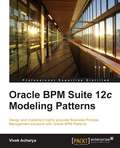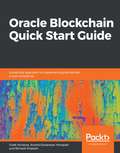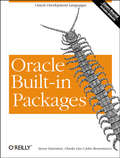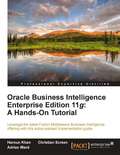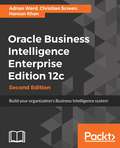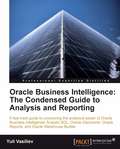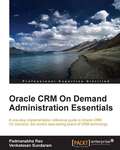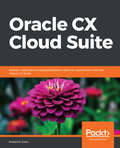- Table View
- List View
Oracle APEX Best Practices
by Learco Brizzi Iloon Ellen Wollf Alex NuijtenIn clearly written chapters you will be guided through different aspects of Oracle Application Express. Varying from setting up your environment to maximizing SQL and PL/SQL. Examples are given based on a simple but appealing case. This book is filled with best practices on how to make the most of Oracle APEX. Developers beginning with application development as well as those who are experienced will benefit from this book. You will need to have basic knowledge of SQL and PL/SQL to follow the examples in this book.
Oracle APEX Cookbook - Second Edition
by Marcel Van Plas Michel Van ZoestAs a Cookbook, this book enables you to create APEX web applications and to implement features with immediately usable recipes that unleash the powerful functionality of Oracle APEX 4.2. Each recipe is presented as a separate, standalone entity and the reading of other, prior recipes is not required.It can be seen as a reference and a practical guide to APEX development.This book is aimed both at developers new to the APEX environment and at intermediate developers. More advanced developers will also gain from the information at hand.If you are new to APEX you will find recipes to start development and if you are an experienced user you will find ways to improve your productivity and efficiency and make the most of APEX to enhance your applications.A little knowledge of PL/SQL, HTML and JavaScript is assumed.
Oracle API Management 12c Implementation
by Andrew Bell Luis Augusto WeirLearn how to successfully implement API management using Oracle's API Management Solution 12c About This Book * Explore the key concepts, goals, and objectives of API Management and learn how to implement it using the Oracle API Management Solution * Understand the concepts and objectives of the Application Service Governance (ASG), along with the governance framework that encompasses people, processes, and technology * Get to grips with API Management readiness assessments, gap analysis, digital reference architecture, and implementation roadmaps Who This Book Is For This book is for Enterprise Architects, Solution Architects, Technical Architects, and SOA and API consultants who want to successfully implement API Management using the Oracle API Management Solution products. What You Will Learn * Understand how to manage a set of APIs * Discover the differences and similarities between API Management and SOA Governance, and where and how these two disciplines converge into Application Services Governance (ASG) * Grasp information about ASG and how to define an ASG governance framework * Understand the challenges for organizations looking to expose APIs to the external world. Identify common scenarios and how to solve them * Define an Oracle API management deployment topology * Install and configure Oracle API Catalog (OAC), Oracle API Manager (OAPIM), and Oracle API Gateway (OAG) * Learn about API subscriptions and API community management with the OAPIM portal * Implement Oracle API Manager (OAPIM) including creation, publishing, management and deprecation of APIs In Detail Oracle SOA Governance is a comprehensive, service-orientated governance solution that is designed to make the transition to SOA easier. API management is the discipline that governs the software development lifecycle of APIs. It defines the tools and processes needed to build, publish and operate APIs including the management of the community of developers around it. This book illustrates how to successfully implement API Management in your organization. To achieve this, the importance of defining an API management strategy and implementation roadmap so that capabilities are implemented in the right order and timeframes is described. It starts by describing all of the fundamental concepts around API Management and related disciplines such as SOA Governance and DevOps in order to dispel the confusion surrounding these topics. The book then takes you on the journey of implementing API Management, using a realistic case study of an organization that needs an API Management solution. You will start by identifying the key business drivers to implement APIs and then create an API Management strategy and a roadmap to realize this strategy. You'll then go through a number of use cases, each focused on addressing specific business requirements. These will help you understand each of the Oracle API Management products, how they fit into an overall architecture, and how to implement them. The book concludes by providing some tips and guidelines around defining a deployment topology for the Oracle API Management products and the steps to install them. Style and approach This book is a comprehensive guide to successfully implementing a complete API Management solution from inception to implementation. The initial chapters introduce you to Oracle SOA Governance and API Management and from there, chapters are mainly hands-on and provide a full step-by-step walkthrough of how to implement the products of the Oracle API management solution to address realistic use cases.
Oracle Advanced PL/SQL Developer Professional Guide
by Saurabh K. GuptaThis book is packed with real world examples that cover all the advanced features of PL/SQL. In turn, each major certification topic is covered in a separate chapter that makes understanding concepts easier. At the end of each chapter, you will find plenty of practice questions to strengthen and test your learning.If you are a PL/SQL developer looking for deeper insight and a move from mid-level programmer to professional database developer, then this is the best guide for you. This book is also an ideal guide for all the Associate level PL/SQL programmers who are preparing for the Professional 1Z0-146 certification. This book assumes you have prior knowledge of PL/SQL programming.
Oracle Application Express 3.2 – The Essentials and More
by Arie GellerThis book is a practical guide that not only shows you how to do things, but also makes you understand how things really work, so you'll be able to develop your own applications. It uses many screenshots, examples, and real-time "APEX code", some of which is documented for the first time. This book is for developers, in general, and web developers, in particular, who wish to learn how to develop data-centric web applications in the Oracle environment. It is also for novice APEX developers, who wish to learn how to use and best utilize the APEX environment, as well as for more experience APEX developers who wish to improve their knowledge and understanding of APEX and its capabilities, and learn from the experience of others. It assumes basic knowledge of HTML, SQL, and PL/SQL. Basic JavaScript understanding is an advantage, and in general can make your life much easier as an APEX developer.
Oracle Application Express 4.0 with Ext JS
by Mark LancasterThis book is written in a clear conversational style, which emphasizes a practical learn-by-doing approach. This step by step guide has illustrative examples to implement Ext JS library features in your Oracle APEX applications If you are an Oracle APEX application developer who wants to take APEX applications to the next level by taking advantage of Ext JS features, this book is for you. Prior knowledge of Oracle APEX is required, however, no prior knowledge of Ext JS is required.
Oracle Application Express Administration
by Francis Mignault Luc DemancheSucceed in managing Oracle Application Express (APEX) environments. This book focuses on creating the right combination of scalability, high-availability, backup and recovery, integrity, and resource control. The book covers everything from simple to enterprise-class deployments, with emphasis on enterprise-level requirements and coverage of cloud and hybrid-cloud scenarios. Many books cover how to develop applications in Oracle APEX. It's a tool with a fast-growing user-base as developers come to know how quick and easy it is to create new applications that run in a browser. However, just getting an application off the ground is only a small part of a bigger picture. Applications must be supported. They must be available when users need them. They must be robust against disaster and secure against malicious attack. These are the issues addressed in Oracle Application Express Administration. These are the issues that when tackled successfully lead to long term success in using Oracle APEX as a rapid application-development toolset. Readers of this book learn how to install the Oracle APEX engine in support of small-scale projects such as at the departmental level, and in support of enterprise-level projects accessed by thousands of users across dozens of time zones. Readers learn to take advantage of Oracle Database's underlying feature set in regards to application scalability and performance, integrity, security, high-availability, and robustness against failure and data loss. Oracle Application Express Administration also describes different cloud solutions, integration with Oracle E-Business Suite, and helps in taking advantage of multitenancy in Oracle Database 12c and beyond. Covers important enterprise considerations such as scalability, robustness, high-availability. Describes cloud-based application deployment scenarios Focuses on creating the right deployment environment for long-term success What You Will Learn Install, upgrade, and configure robust APEX environments Back up and recover APEX applications and their data Monitor and tune the APEX engine and its applications Benefit from new administration features in APEX 5. 0 Run under multi-tenant architecture in Oracle Database 12c Manage the use of scarce resources with Resource Manager Secure your data with advanced security features Build high-availability into your APEX deployments Integrate APEX with Oracle E-Business Suite Who This Book Is For Architects, administrators, and developers who want to better understand how APEX works in a corporate environment. Readers will use this book to design deployment architectures around Oracle Database strengths like multi-tenancy, resource management, and high availability. The book is also useful to administrators responsible for installation and upgrade, backup and recovery, and the ongoing monitoring of the APEX engine and the applications built upon it.
Oracle Application Express Forms Converter
by Douwe Pieter van den BosPacked with plentiful screenshots and clear explanations, this book is a step-by-step tutorial that demonstrates a successful Oracle Forms to Oracle APEX Conversion project. This book is for Oracle Forms developers who want to migrate to Oracle APEX. The book will also be useful for Oracle APEX developers who want to convert their older Forms applications to Oracle APEX applications.
Oracle Application Integration Architecture (AIA) Foundation Pack 11gR1: Essentials
by Hariharan V GanesarethinamThis book is written in simple, easy to understand format with lots of screenshots and step-by-step explanations. If you are a Business Analyst, Integration Architect or Developer, working in Oracle applications integration, looking forward to understanding Oracle AIA fundamentals and development practice, then this is the best guide for you. This book assumes that you have a fundamental knowledge of Oracle SOA Suite and its components.
Oracle Application Server 10g Essentials
by Rick Greenwald Robert Stackowiak Donald BalesThis new guide provides the perfect introduction to the Oracle Application Server for users of any level. Divided into three concise sections, the book covers server basics, core components, and server functionality. Designed to be the ideal first OracleAS book, Oracle Application Server 10g Essentials offers Oracle application developers and administrators everything they need to know to use this powerful server effectively and efficiently.
Oracle Autonomous Database in Enterprise Architecture: Utilize Oracle Cloud Infrastructure Autonomous Databases for better consolidation, automation, and security
by Bal Mukund Sharma Krishnakumar KM Rashmi PandaGet up to speed with Oracle's Autonomous Databases and implementation strategies for any workload or use case, including transactional, data warehousing, and non-relational databasesKey FeaturesExplore ADB, its business benefits, and architectural considerationsMigrate the existing workload to ADB, explore high availability, and use cloud native methods for monitoring and event notificationsLeverage APEX, JSON, the REST API, and SQL Developer Web features for rapid developmentBook DescriptionOracle Autonomous Database (ADB) is built on the world's fastest Oracle Database Platform, Exadata, and is delivered on Oracle Cloud Infrastructure (OCI), customer data center (ExaCC), and Oracle Dedicated Region Cloud. This book is a fast-paced, hands-on introduction to the most important aspects of OCI Autonomous Databases.You'll get to grips with concepts needed for designing disaster recovery using standby database deployment for Autonomous Databases. As you progress, you'll understand how you can take advantage of automatic backup and restore. The concluding chapters will cover topics such as the security aspects of databases to help you learn about managing Autonomous Databases, along with exploring the features of Autonomous Database security such as Data Safe and customer-managed keys for Vaults.By the end of this Oracle book, you'll be able to build and deploy an Autonomous Database in OCI, migrate databases to ADB, comfortably set up additional high-availability features such as Autonomous Data Guard, and understand end-to-end operations with ADBs.What you will learnExplore migration methods available for Autonomous Databases, using both online and offline methodsCreate standby databases, RTO and RPO objectives, and Autonomous Data Guard operationsBecome well-versed with automatic and manual backups available in ADBImplement best practices relating to network, security, and IAM policiesManage database performance and log management in ADBUnderstand how to perform data masking and manage encryption keys in OCI's Autonomous DatabasesWho this book is forThis book is for decision makers, enterprise cloud architects, solution consultants, cloud engineers, implementation partners, and technology students, as well as anyone who wants to learn about Oracle's Autonomous Databases delivered on Oracle Cloud Infrastructure (OCI). Beginner-level knowledge of Linux and OCI and networking concepts and databases, along with hands-on experience in OCI environments is required before getting started with this book.
Oracle BAM 11gR1 Handbook
by Pete Wang"Oracle BAM 11gR1 Handbook" is a practical best practices tutorial focused entirely on Oracle Business Activity Monitoring. An intermediate-to-advanced guide, step-by-step instructions and an accompanying demo project will help SOA report developers through application development and producing dashboards and reports. If you are a developer/report developer or SOA Architect who wants to learn valuable Oracle BAM best practices for monitoring your operations in real time, then "Oracle BAM 11gR1 Handbook" is for you. Administrators will also find the book useful. You should already be comfortable with SOA architecture and SQL practices.
Oracle BI Publisher 11g: A Practical Guide to Enterprise Reporting
by Daniela BozdocThis is a practical guide with step-by step instructions for enhancing your application of Oracle BI Publisher 11g for enterprise reporting. If you are an Oracle BI Publisher 11g end user, be it a report developer, business analyst or consultant, this book is for you. You should have good knowledge of general reporting practices and XML/XSL programming, though experience of using BI/XML publisher is not essential.
Oracle BPM Suite 11g Developer's cookbook
by Vivek AcharyaThis book is written in simple, easy to understand format with lots of screenshots and step-by-step explanations. If you are a BPM,Oracle SOA or Oracle Fusion Applications - developer, designer, artitect, end-user looking to develop BPM solutions without impediments, then this is the best guide for you. Book assume that you have fundamental knowledge of BPM.
Oracle BPM Suite 11g: Advanced BPMN Topics
by Tanya Williams Mark NelsonOracle BPM Suite is a popular and highly capable business process management system with extensive integration capabilities. BPMN, one of the most widely used process modeling notations, includes advanced capabilities for inter-process communication, working of arrays of data, and handling exceptions. However, these very same areas are often poorly understood. This book gives you the knowledge to create professional process models using these advanced features of BPMN. "Oracle BPM Suite 11g: Advanced BPMN Topics" is the only book available that provides coverage of advanced BPMN topics for Oracle BPM Suite, helping to fill in the gaps left by the product documentation, and giving you the information that you need to know to use BPMN to its full potential. This book covers the important theory behind inter-process communication, working with arrays and handling exceptions in BPMN, along with detailed, step-by-step practical exercises that demonstrate and consolidate this theoretical knowledge. Throughout the book we'll cover topics including different types of sub-processes, initializing and manipulating arrays, using the multi-instance embedded sub-process, fault propagation and more. With "Oracle BPM Suite 11g: Advanced BPMN Topics" in hand, you'll gain detailed and practical experience in using the advanced features of BPMN to create professional BPMN processes with Oracle BPM. "Oracle BPM Suite 11g: Advanced BPMN Topics" is a concise tutorial which treats each topic to both a theoretical and practical approach. If you are a developer or architect working with Oracle BPM Suite 11g, this book is for you. Basic knowledge of BPM Suite and business process management in general is assumed.
Oracle BPM Suite 12c Modeling Patterns
by Vivek AcharyaThis book is an invaluable resource if you are an Enterprise architect, solution architect, developer, process analyst, or application functional and technical consultant who uses Business Process Management and BPMN to model and implement Enterprise IT applications, SaaS, and cloud applications.
Oracle Blockchain Quick Start Guide: A practical approach to implementing blockchain in your enterprise
by Vivek Acharya Anand Eswararao Yerrapati Nimesh PrakashGet up and running with Oracle's premium cloud blockchain services and build distributed blockchain apps with ease Key Features Discover Hyperledger Fabric and its components, features, qualifiers, and architecture Get familiar with the Oracle Blockchain Platform and its unique features Build Hyperledger Fabric-based business networks with Oracle's premium blockchain cloud service Book Description Hyperledger Fabric empowers enterprises to scale out in an unprecedented way, allowing organizations to build and manage blockchain business networks. This quick start guide systematically takes you through distributed ledger technology, blockchain, and Hyperledger Fabric while also helping you understand the significance of Blockchain-as-a-Service (BaaS). The book starts by explaining the blockchain and Hyperledger Fabric architectures. You'll then get to grips with the comprehensive five-step design strategy - explore, engage, experiment, experience, and in?uence. Next, you'll cover permissioned distributed autonomous organizations (pDAOs), along with the equation to quantify a blockchain solution for a given use case. As you progress, you'll learn how to model your blockchain business network by defining its assets, participants, transactions, and permissions with the help of examples. In the concluding chapters, you'll build on your knowledge as you explore Oracle Blockchain Platform (OBP) in depth and learn how to translate network topology on OBP. By the end of this book, you will be well-versed with OBP and have developed the skills required for infrastructure setup, access control, adding chaincode to a business network, and exposing chaincode to a DApp using REST configuration. What you will learn Model your blockchain-based business network by defining its components, transactions, integrations, and infrastructure through use cases Develop, deploy, and test chaincode using shim and REST, and integrate it with client apps using SDK, REST, and events Explore accounting, blockchain, hyperledger fabric, and its components, features, qualifiers, architecture and structure Understand the importance of Blockchain-as-a-Service (BaaS) Experiment Hyperledger Fabric and delve into the underlying technology Set up a consortium network, nodes, channels, and privacy, and learn how to translate network topology on OBP Who this book is for If you are a blockchain developer, blockchain architect or just a cloud developer looking to get hands-on with Oracle Blockchain Cloud Service, then this book is for you. Some familiarity with the basic concepts of blockchain will be helpful to get the most out of this book
Oracle Built-in Packages
by Steven Feuerstein Charles Dye John BeresniewiczOracle is the most popular database management system in use today, and PL/SQL plays a pivotal role in current and projected Oracle products and applications. PL/SQL is a programming language providing procedural extensions to the SQL relational database language and to an ever-growing number of oracle development tools. originally a rather limited tool, PL/SQL became with Oracle7 a mature and effective language for developers. now, with the introduction of Oracle8, PL/SQL has taken the next step towards becoming a fully realized programming language providing sophisticated object-oriented capabilities. Steven Feuerstein's Oracle PL/SQL Programming is a comprehensive guide to building applications with PL/SQL. That book has become the bible for PL/SQL developers who have raved about its completeness, readability, and practicality. Built-in packages are collections of PL/SQL objects built by Oracle Corporation and stored directly in the Oracle database. The functionality of these packages is available from any programming environment that can call PL/SQL stored procedures, including Visual Basic, Oracle Developer/2000, Oracle Application Server (for web-based development), and, of course, the Oracle database itself. Built-in packages extend the capabilities and power of PL/SQL in many significant ways. for example: DBMS_SQL executes dynamically constructed SQL statements and PL/SQL blocks of code. DBMS_PIPE communicates between different Oracle sessions through a pipe in the RDBMS shared memory. DBMS_JOB submits and manages regularly scheduled jobs for execution inside the database. DBMS_LOB accesses and manipulates Oracle8's large objects (LOBs) from within PL/SQL programs. The first edition of Oracle PL/SQL Programming contained a chapter on Oracle's built-in packages. but there is much more to say about the basic PL/SQL packages than Feuerstein could fit in his first book. In addition, now that Oracle8 has been released, there are many new Oracle8 built-in packages not described in the PL/SQL book. There are also packages extensions for specific oracle environments such as distributed database. hence this book. Oracle Built-in Packages pulls together information about how to use the calling interface (API) to Oracle's Built-in Packages, and provides extensive examples on using the built-in packages effectively. The windows diskette included with the book contains the companion guide, an online tool developed by RevealNet, Inc., that provides point-and-click access to the many files of source code and online documentation developed by the authors. The table of contents follows: Preface Part I: Overview1. Introduction Part II: Application Development Packages Executing Dynamic SQL and PL/SQL Intersession Communication User Lock and Transaction Management Oracle Advanced Queuing Generating Output from PL/SQL Programs Defining an Application Profile Managing Large Objects Datatype Packages Miscellaneous Packages Part III: Server Management Packages Managing Session Information Managing Server Resources Job Scheduling in the Database Part IV: Distributed Database Packages Snapshots Advanced Replication Conflict Resolution Deferred Transactions and Remote Procedure Calls Appendix. What's on the companion disk?
Oracle Business Intelligence 11g R1 Cookbook
by Cuneyt YilmazProviding simple solutions, useful techniques and best practices to ensure that your business is intelligent as it can possibly be, this book is a must buy for anyone that works with Oracle BI.If you are a business analyst, BI administrator or developer working with Oracle Business Intelligence 11g R1 then this book is exactly what you have been looking for. Hands on practical examples, real world solutions and best practices make this book an essential guide for Oracle BI. Clear a space on your desk as you won't want this handy reference to be too far away.
Oracle Business Intelligence Enterprise Edition 11g: A Hands-On Tutorial
by Christian ScreenOracle Business Intelligence Enterprise Edition 11g: A Hands- On Tutorial
Oracle Business Intelligence Enterprise Edition 12c - Second Edition
by Christian Screen Adrian Ward Haroun KhanA comprehensive guide from Oracle experts, that will act as your single point of reference for building an Oracle BI 12c system that turns data in actionable insight. About This Book • Come, start your first Oracle Business intelligence system and excel in BI with this exhaustive guide • An all-encompassing guide for your Oracle business intelligence needs • Learn from the self-paced professional guidance and implement Oracle business intelligence using this easy-to-follow guide by our experts Who This Book Is For If your job includes working on data, improving the financial or operational performance of your organization or you are a consultant for the above, then this book is for you. If you have been placed on a business intelligence project, then this book is for you. If you are the Project Manager, Business Analyst or Data Scientist then this book is for you. If you are an end user of Oracle Business Intelligence, then this book is for you too. Having a basic understanding of databases and the use of Business Intelligence is expected, but no knowledge of Oracle BI is required. What You Will Learn • Install OBIEE in Windows, including how to create the underlying Weblogic Application server and the required database • Build the BI system repository, the vital engine connecting your data to the front end of Oracle BI • Develop effective analysis, draw out meaning from the data, and present it to end users on interactive dashboards • Build pixel-perfect, printable reports using the embedded BI Publisher feature • Build agents for actionable insight and enable your users to act on Business Intelligence at their desktop or on the move • Understand the various aspects of securing the Oracle BI system, from data restrictions to whole dashboard access rights • Get acquainted with the system management tools and methods available for the continuous improvement of your system In Detail Oracle Business Intelligence Enterprise Edition (OBIEE) 12c is packed full of features and has a fresh approach to information presentation, system management, and security. OBIEE can help any organization to understand its data, to make useful information from data, and to ensure decision-making is supported by facts. OBIEE can focus on information that needs action, alerting users when conditions are met. OBIEE can be used for data analysis, form production, dashoarding, and workflow processes. We will introduce you to OBIEE features and provide a step-by-step guide to build a complete system from scratch. With this guide, you will be equipped with a good basic understanding of what the product contains, how to install and configure it, and how to create effective Business Intelligence. This book contains the necessary information for a beginner to create a high-performance OBIEE 12c system. This book is also a guide that explains how to use an existing OBIEE 12c system, and shows end users how to create. Style and approach This book will take you from one feature to another in a step-by-step manner and will teach how you can create effective business intelligence using Oracle Business Intelligence Enterprise Edition. You will be taught how to create BI solutions and dashboards from scratch. There will be multiple modules in the book, each module spread in chapters, that will cover one aspect of business intelligence in a systematic manner.
Oracle Business Intelligence and Essbase Solutions Guide
by Lakshman Bulusu Rosendo AbelleraThis book highlights the practical aspects of using Oracle Essbase and Oracle Business Intelligence Enterprise Edition (OBIEE) as a comprehensive BI solution. It explains the key steps involved in Oracle Essbase and OBIEE implementations. Using case studies, the book covers Oracle Essbase for analytical BI and data integration, using OBIEE for operational BI including presentation services and BI Publisher for real-time reporting services, Self-service BI– in terms of VLDB, scalability, high performance, stability, long-lasting and ease of use that saves time, effort, and costs, while maximizing ROI.
Oracle Business Intelligence: The Condensed Guide to Analysis and Reporting
by Yuli VasilievThis book is a quick guide to getting started with Oracle Business Intelligence SE platform that will answer common business questions and help you make quick business decisions. The examples in this book will help you prepare the database for analysis and create business reports in no time. If you are an business analyst, a report builder, a DBA, or an application developer who wants to learn how to use the Oracle Business Intelligence platform for analysis and reporting, this is the perfect book for you. Previous knowledge of Oracle Business Intelligence tools is not required, but you should have a competent grasp of using an Oracle Database.
Oracle CRM On Demand Administration Essentials
by Venkatesan Sundaram Padmanabha RaoThis book is packed with real world examples that cover the design and discipline of the software and service of CRMOD. If you are a CRMOD Administrator, business analyst, or an integration specialist looking forward to implementing CRMOD in your organization and interested in developing business applications integral to CRMOD, then this is the best guide for you. This book assumes you have basic knowledge of CRMOD.
Oracle CX Cloud Suite: Deliver A Seamless And Personalized Customer Experience With The Oracle Cx Suite
by Kresimir JuricThis book is meant for anybody who understands or is willing to learn CX concepts and has basic technical knowledge; After reading this book you will acquire skills and knowledge needed to optimally use your Oracle CX and tailor unforgettable experience for your customer.
